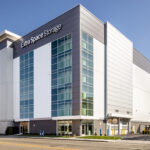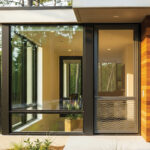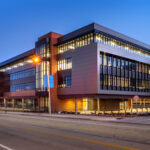
Photos courtesy Kingspan Light + Air
Metal buildings are known for their robustness, versatility, and cost-efficiency. However, recent years have witnessed a notable shift towards sustainability and innovation within the metal building materials market. Driven by escalating concerns regarding environmental impact and the imperative to meet sustainability initiatives laid out by the Paris Climate Accords, industry players are increasingly focusing on the development of products that not only align with these demands but also surpass them.
The 2023 Global Metal Building Materials Market report has underscored a consistent growth trajectory in recent years, with projections indicating continued expansion until 2030. Notably, with the increase in the number of more sustainable products manufacturers bring forth, the industry increasingly acknowledges the significance of integrating environmentally responsible practices into their operations.
Consumer awareness
driving innovation
A primary component propelling this shift is the burgeoning consumer awareness regarding health and wellness. As individuals become more aware of the repercussions of their choices on the environment, there is a growing demand for products that resonate with their values. In response, manufacturers are innovating metal building materials that exhibit durability, efficiency, and sustainability, including the use of recycled materials, energy-efficient production processes, and eco-friendly manufacturing methods.

Integrating natural daylight
A growing sector in modern metal building construction is the integration of natural daylight, driven by imperatives of energy conservation and enhancing occupant comfort and productivity. Research has demonstrated that harnessing natural daylight not only curtails lighting energy consumption by reducing reliance on daytime electric lighting but also decreases lighting-related cooling energy consumption. One study by the Energy Center of Wisconsin indicated an overall operating cost savings of 22 percent for the test rooms relative to the control rooms, with 32 percent lower lighting energy use and
25 percent lower cooling energy requirements.
Additionally, effective daylighting designs foster a better work environment conducive to heightened employee well-being and productivity. According to a study by Future Workplace titled “The Employee Experience,” employees agree that access to natural light and views enhances their overall happiness and well-being (78 percent), work satisfaction (73 percent), work performance (70 percent) and organizational commitment (54 percent). The study also shows over one third of employees feel they do not receive enough natural light in their workspace. Additionally, 47 percent of employees admit to feeling tired or very tired due to the absence of natural light or a window in their office, while 43 percent report feeling gloomy due to the lack of light.
Advancements in cutting-edge daylighting technologies
Integrating natural daylight into metal buildings presents inherent challenges, requiring innovative solutions to uphold building envelope integrity while maximizing controlled daylight penetration. Fortunately, technological advancements have led to sophisticated solutions such as Tubular Daylighting Devices (TDDs), metal-framed glass skylights, and polycarbonate translucent wall and roof systems. These advancements not only enhance daylighting but also preserve the building’s integrity, improve energy efficiency, and boost occupant comfort and productivity.
Tubular daylighting devices (TDDs)
TDDs employ highly reflective materials and precision-engineered components to capture sunlight at the rooftop level, guiding it through a network of reflective tubes to a diffuser installed within the building. This diffusion mechanism ensures uniform dispersion and careful placement of the daylight, minimizing glare and maximizing the benefits of natural daylight for occupants within the building. Additionally, TDDs often incorporate advanced control systems, allowing users to regulate the intensity and direction of incoming sunlight, further enhancing their versatility and functionality in diverse architectural contexts. Due to their adaptability, TDDs work seamlessly in both new construction and retrofits, offering an environmentally conscious and technologically advanced solution for maximizing natural daylight in metal buildings.

roof assemblies.
Metal framed glass skylights
Metal framed glass skylights seamlessly integrate into metal buildings, providing a harmonious fusion of structural integration and optical clarity. By allowing unobstructed daylight into the facility, metal framed glass skylights enhance the interior ambiance while preserving the architectural integrity of the building. These skylights offer a diverse range of UV-stable glass glazing options, including high-performance insulating glass and laminated glass, as well as standard and customizable configurations, empowering architects with unparalleled design flexibility.
In response to the escalating demand for sustainability, leading metal framed glass skylights incorporate glass and aluminum with pre-consumer recycled content and post-consumer recyclability. Featuring thermally improved framing tailored for cold climate applications, they can bolster energy efficiency and minimize the building’s carbon footprint, seamlessly combining aesthetic appeal, environmental responsibility, and functional excellence.
Polycarbonate translucent wall and roof assemblies
Similarly, polycarbonate translucent wall and roof assemblies present a lightweight and robust alternative to traditional curtainwall and architectural skylight applications, addressing the need for effective daylighting solutions in metal buildings. These panels allow diffused sunlight to penetrate the building, creating a well-lit and inviting interior space while simultaneously mitigating issues associated with glare and heat buildup. Their lightweight nature is particularly advantageous in metal building construction, where structural considerations demand durable and easy-to-install materials. By incorporating polycarbonate translucent panels into metal building designs, architects and builders can strike a harmonious balance between functionality and aesthetics, optimizing natural daylight utilization while ensuring the structural integrity of the building envelope. Additionally, the versatility of polycarbonate panels allows for various design configurations, including customizable panel colors, providing architects with ample opportunities for creative expression and customization to suit a project’s specific needs and aesthetic preferences.
Future prospects and industry growth opportunities
Customizable daylighting systems cater to diverse performance and aesthetic requisites, including sound control, custom colors, and specialized features such as hurricane and blast protection. By embracing these advanced daylighting solutions, metal building owners can capitalize on the benefits of daylight design without compromising structural integrity or architectural finesse, thereby fostering energy efficiency, occupant well-being and productivity.
The metal building materials market is experiencing a clear shift towards sustainability and better-built buildings. This trend is driving sustained growth as companies merge environmentally responsible practices with technological advancements. There is significant potential for further innovation and progress in the industry, particularly in the use of advanced products currently on the market to create more sustainable, healthier, and durable buildings. Manufacturers can also continue to contribute to this growth by investing in research and development to meet evolving consumer demands and sustainability goals, further paving the way for more sustainable and technologically advanced metal building solutions.
Neall Digert, Ph.D., MIES, vice president, innovation, and market development, Kingspan Light + Air | North America, has over thirty years of consulting and education experience working in the energy/lighting/daylighting design and research fields. www.kingspanlightand air.us






